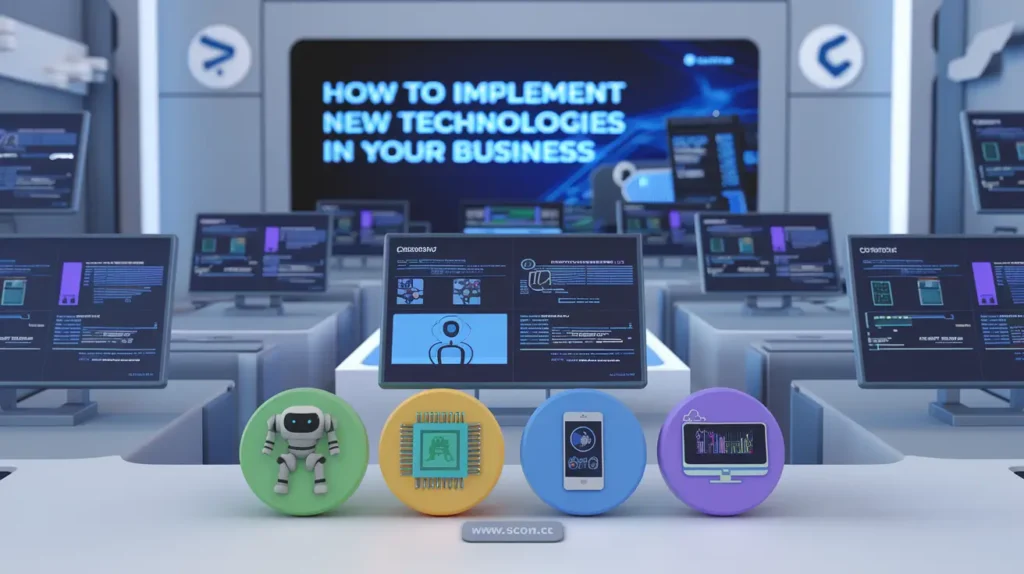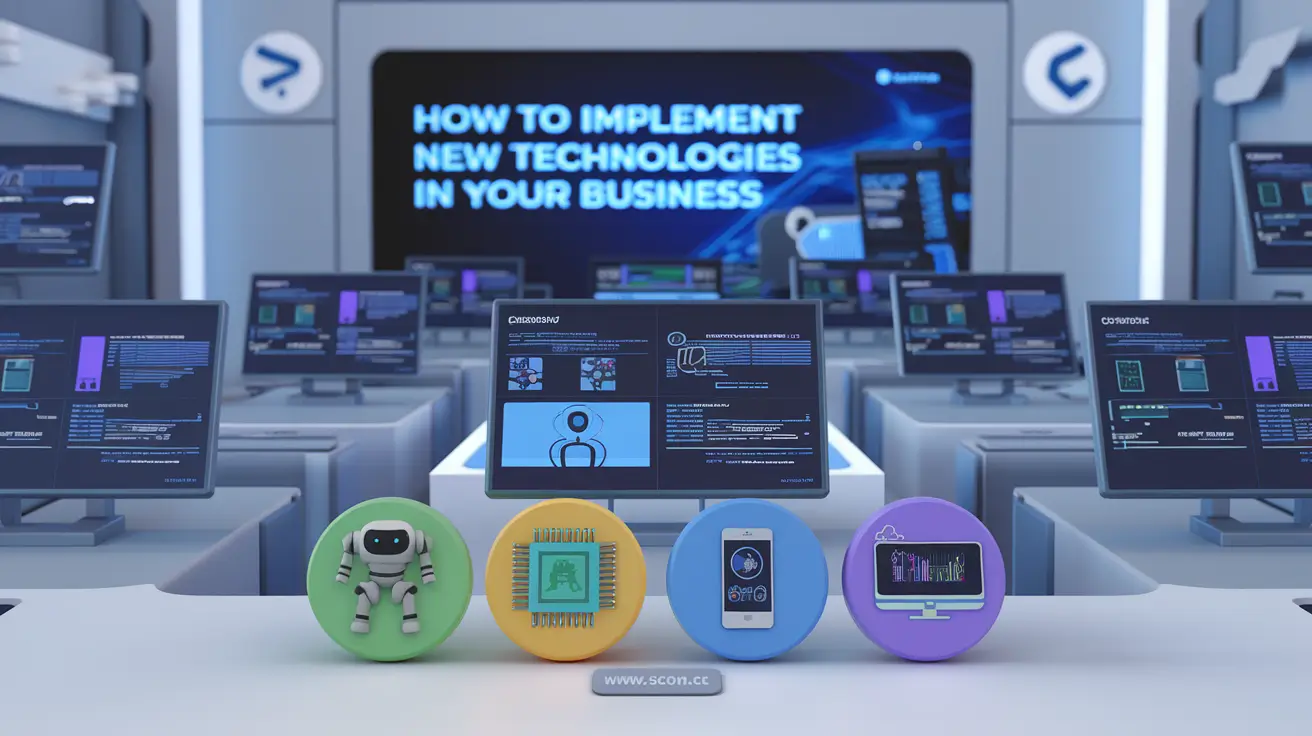How to Implement New Technologies in Your Business

- How to Implement New Technologies in Your Business
- Assess Your Current Technology and Needs
- Develop a Technology Adoption Plan
- Choose the Right Technology
- Train Your Team
- Implement the Technology
- Evaluate the Technology
- Stay Updated with Technological Trends
- Summary Table
-
FAQ
- What is the first step in implementing new technology in a business?
- How can I ensure a smooth technology implementation process?
- What factors should I consider when choosing new technology?
- How important is training when implementing new technology?
- How can I evaluate the effectiveness of new technology?
- How can I stay informed about the latest technological trends?
- What should I do if I encounter issues during technology implementation?
How to Implement New Technologies in Your Business
In today’s rapidly evolving business landscape, adopting new technologies can provide a competitive edge, improve efficiency, and enhance customer experiences. However, implementing new technologies requires careful planning and execution to ensure successful integration and realisation of benefits. This guide provides a comprehensive approach to implementing new technologies in your business, covering key steps from planning to evaluation.
Assess Your Current Technology and Needs
Before introducing new technologies, it’s crucial to assess your current technological landscape and identify your specific needs. This process involves several key steps:
- Evaluate Existing Technology: Review the technology currently in use within your business. Assess its effectiveness, limitations, and areas for improvement. Consider both hardware and software.
- Identify Pain Points: Determine the challenges and inefficiencies faced by your team. Common issues might include outdated systems, slow processes, or lack of integration.
- Define Objectives: Establish clear objectives for implementing new technology. Objectives may include improving productivity, enhancing customer service, or streamlining operations.
- Consult with Stakeholders: Engage with key stakeholders, including employees, managers, and IT staff, to gather insights and ensure alignment with business goals.
- Research Technology Solutions: Explore available technology solutions that address your identified needs and objectives. Consider factors such as features, scalability, and cost.
Develop a Technology Adoption Plan
A well-structured technology adoption plan is essential for a smooth implementation process. Here’s how to develop one:
- Set Clear Goals: Define specific, measurable goals for the technology implementation. Goals should align with your overall business objectives and address the identified needs.
- Create a Budget: Develop a budget that includes the cost of technology, implementation, training, and ongoing maintenance. Factor in potential hidden costs, such as downtime or productivity loss during the transition.
- Establish a Timeline: Set a realistic timeline for implementation, including key milestones and deadlines. Consider the complexity of the technology and the availability of resources.
- Assign Responsibilities: Designate a project manager or team responsible for overseeing the implementation. Assign roles and responsibilities to ensure accountability and smooth execution.
- Develop a Risk Management Plan: Identify potential risks associated with the technology implementation and develop strategies to mitigate them. Risks may include technical issues, resistance to change, or budget overruns.
Choose the Right Technology
Selecting the right technology solution is critical to achieving your implementation goals. Consider the following factors when choosing new technology:
- Functionality: Ensure the technology meets your business needs and objectives. Evaluate its features, capabilities, and compatibility with existing systems.
- Ease of Use: Choose technology that is user-friendly and easy for your team to learn and adopt. A steep learning curve can hinder productivity and increase resistance.
- Scalability: Opt for technology that can grow with your business. Scalability ensures that the solution remains effective as your business expands and evolves.
- Integration: Verify that the new technology integrates seamlessly with your existing systems and processes. Integration minimizes disruptions and enhances efficiency.
- Vendor Support: Assess the level of support provided by the technology vendor. Reliable customer support, training, and resources are crucial for successful implementation.
Train Your Team
Effective training is essential for ensuring that your team can use the new technology efficiently. Follow these steps to provide comprehensive training:
- Develop a Training Plan: Create a training plan that outlines the objectives, schedule, and content of the training sessions. Include both technical and operational aspects of the technology.
- Provide Hands-On Training: Offer hands-on training sessions where employees can practice using the technology in a controlled environment. This helps build confidence and familiarity.
- Utilize Multiple Training Methods: Use various training methods, such as workshops, online tutorials, and user manuals, to accommodate different learning styles and preferences.
- Offer Ongoing Support: Provide ongoing support and resources to help employees troubleshoot issues and continue learning. Consider setting up a helpdesk or support team.
- Gather Feedback: Collect feedback from employees regarding the training process and technology usability. Use this feedback to make improvements and address any concerns.
Implement the Technology
With your plan and training in place, it’s time to implement the new technology. Follow these steps for a successful implementation:
- Pilot Testing: Conduct a pilot test with a small group of users to identify potential issues and gather feedback. Pilot testing helps refine the implementation process and mitigate risks.
- Gradual Rollout: Implement the technology in phases to minimize disruptions and allow time for adjustments. A gradual rollout ensures that any issues can be addressed before full deployment.
- Monitor Performance: Monitor the technology’s performance and its impact on business operations. Track key metrics to assess its effectiveness and identify areas for improvement.
- Address Issues Promptly: Be prepared to address any issues that arise during the implementation process. Quick resolution of problems helps maintain productivity and user satisfaction.
- Communicate Clearly: Keep communication open and transparent throughout the implementation process. Regular updates and clear instructions help manage expectations and reduce resistance.
Evaluate the Technology
After implementation, it’s important to evaluate the technology’s performance and impact on your business. Consider the following evaluation steps:
- Assess Achievement of Goals: Review whether the technology has met the goals and objectives outlined in your adoption plan. Evaluate its contribution to productivity, efficiency, and overall business performance.
- Gather User Feedback: Solicit feedback from users to understand their experiences with the technology. Address any concerns and make adjustments as needed.
- Analyze Performance Metrics: Analyze performance metrics to measure the technology’s effectiveness. Metrics may include usage rates, error rates, and cost savings.
- Review ROI: Evaluate the return on investment (ROI) by comparing the technology’s benefits to its costs. Determine whether the technology has provided a positive impact on your business.
- Plan for Future Updates: Consider future updates and enhancements to keep the technology aligned with evolving business needs and technological advancements.
Stay Updated with Technological Trends
Technology is continuously evolving, and staying updated with the latest trends can help you maintain a competitive edge. Here’s how to stay informed:
- Follow Industry News: Keep up with industry news and technological advancements through trade publications, blogs, and news websites.
- Attend Conferences and Seminars: Participate in technology conferences, seminars, and webinars to learn about new technologies and trends.
- Join Professional Networks: Join professional networks and forums to connect with industry experts and peers. Networking provides insights and opportunities for collaboration.
- Invest in Continuous Learning: Encourage ongoing learning and development for yourself and your team to stay current with technological advancements.
- Evaluate Emerging Technologies: Regularly assess emerging technologies to determine their potential benefits for your business. Staying proactive ensures that you are prepared for future technological changes.
Summary Table
| Topic | Key Points |
|---|---|
| Assess Your Current Technology and Needs | Evaluate existing technology, identify pain points, define objectives, consult stakeholders, research solutions. |
| Develop a Technology Adoption Plan | Set goals, create a budget, establish a timeline, assign responsibilities, and develop a risk management plan. |
| Choose the Right Technology | Ensure functionality, ease of use, scalability, integration, and vendor support. |
| Train Your Team | Develop a training plan, provide hands-on training, use multiple methods, offer ongoing support, gather feedback. |
| Implement the Technology | Conduct pilot testing, use gradual rollout, monitor performance, address issues promptly, communicate clearly. |
| Evaluate the Technology | Assess goal achievement, gather user feedback, analyze performance metrics, review ROI, plan for future updates. |
| Stay Updated with Technological Trends | Follow industry news, attend conferences, join professional networks, invest in continuous learning, evaluate emerging technologies. |
FAQ
What is the first step in implementing new technology in a business?
The first step is to assess your current technology and needs. Evaluate existing systems, identify pain points, define clear objectives, and research technology solutions that align with your goals.
How can I ensure a smooth technology implementation process?
Develop a comprehensive technology adoption plan, including clear goals, a budget, a timeline, and a risk management strategy. Train your team effectively, conduct pilot testing, and implement the technology gradually.
What factors should I consider when choosing new technology?
Consider factors such as functionality, ease of use, scalability, integration with existing systems, and the level of vendor support. Ensure the technology meets your business needs and objectives.
How important is training when implementing new technology?
Training is crucial for ensuring that your team can effectively use the new technology. Provide hands-on training, utilize various methods, and offer ongoing support to help employees adapt and become proficient.
How can I evaluate the effectiveness of new technology?
Evaluate the technology by assessing whether it has met your goals, gathering user feedback, analyzing performance metrics, reviewing ROI, and planning for future updates. This helps determine its impact and value.
How can I stay informed about the latest technological trends?
Stay informed by following industry news, attending conferences and seminars, joining professional networks, investing in continuous learning, and evaluating emerging technologies relevant to your business.
What should I do if I encounter issues during technology implementation?
Address issues promptly by monitoring performance, troubleshooting problems, and seeking support from the technology vendor or a technical expert. Effective communication and a well-prepared risk management plan can help resolve issues quickly.

If you enjoyed this article and found it valuable, we encourage you to explore our news and valuable information section, where you'll find more relevant and up-to-date content that may pique your interest. Additionally, if you are seeking advice or need guidance on a specific topic, we suggest visiting our services section. There, you will find a variety of options designed to assist and support you in addressing your needs. Feel free to check out both sections to get the information and assistance that best suits your requirements.

Leave a Reply